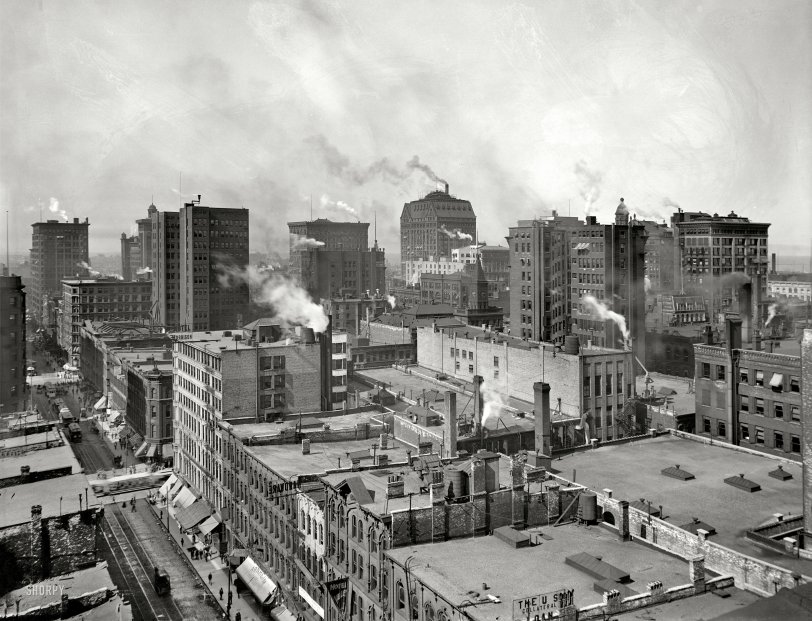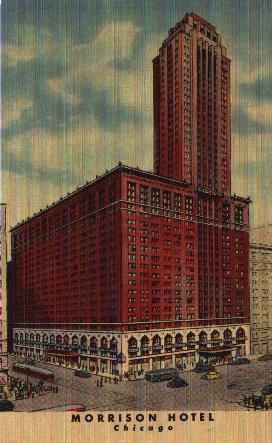


Framed or unframed, desk size to sofa size, printed by us in Arizona and Alabama since 2007. Explore now.
Shorpy is funded by you. Patreon contributors get an ad-free experience.
Learn more.

- Baldwin 62303
- Baldwin VO-1000
- Cold
- No expense spared
- Tough Guys
- Lost in Toyland
- And without gloves
- If I were a blindfolded time traveler
- Smoke Consumer Also Cooks
- Oh that stove!
- Possibly still there?
- What?!?
- $100 Reward
- Freeze Frame
- Texas Flyer wanted
- Just a Year Too Soon
- WWII -- Replacing men with women at the railroad crossing.
- Yes, Icing
- You kids drive me nuts!
- NOT An Easy Job
- I wonder
- Just add window boxes
- Icing Platform?
- Indiana Harbor Belt abides
- Freezing haze
- Corrections (for those who care)
- C&NW at Nelson
- Fallen Flags
- A dangerous job made worse
- Water Stop
Print Emporium
Heart of Chicago: 1901

Circa 1901. "The Heart of Chicago." An amazingly detailed (and smoky) tableau. 8x10 inch dry plate glass negative, Detroit Publishing Company. View full size.
Yes, it is a Spiral Staircase (or a Half-Spiral)
That building, seen from the back, is the Hartford Building (Henry Ives Cobb, architect, 1893) at the southwest corner of Dearborn and Madison Streets. The early skyscrapers of the day usually had only one staircase, and it was not fire-protected. The Rookery in Chicago (Burnham and Root, 1885-1888) has a similar semicircular spiral staircase rising up one side of its interior light court.
What is it?
Does anyone have any idea what the part of the building is that has spiraling windows just to the left of the three awnings in the right third of the photo? I'd guess it houses a spiral staircase, but have never seen anything like it before.
The Jungle
I can imagine Jurgis Rudkus walking aimlessly through these streets.
Too darn hot
With the obvious lack of AC units on the roofs, it's plain to see why so many windows were open. Offices with a window must have gone for a premium. Try to imagine the people in the inner offices trying to work wearing the heavy clothing of the time. "Of course you can use my fan, Myrtle."
[Inner offices in large buildings would have windows opening on an air shaft - Dave]
Do we still need Kodak?
For the photogs who visit this site: are there digital cameras capable of capturing this scene, or do we still need large format cameras?
[A large- or medium-format digital camera would be more than up to the task. - Dave]
If yer feeling ambitious
For anyone wishing to re-create this view today, the photographer's vantage was the current site of Harris Bank at 111 West Monroe.
The Boston Store
Seems a little misplaced. Otherwise, I think the Boyce Building is still there.
Fantastic View!
The street running along the left side of the picture is Clark Street, looking north from approximately Monroe Street (Madison Street is the cross street with the blurry cable car train whizzing by). The notable tall buildings visible include: the Ashland Block (at the far left), the Schiller Building (to the right of the Ashland Block and partially obscured), the Unity Building (behind the "Boyce Building"), the Masonic Temple (the tallest one in sight) and the first Champlain Building (at the far right, next to the smaller building marked "Boston Store"). Needless to say, all of these have been demolished; the Champlain was the first to go - in 1916 - for the expansion of the Boston Store.
Clark Street
Arnheim the Tailor places this picture roughly at 155-157 South Clark Street.
You can also see the original version of the Morrison Hotel, which eventually was expanded to 40 stories. The building was razed in 1965 and is now the site of the First National Bank.

























On Shorpy:
Today’s Top 5